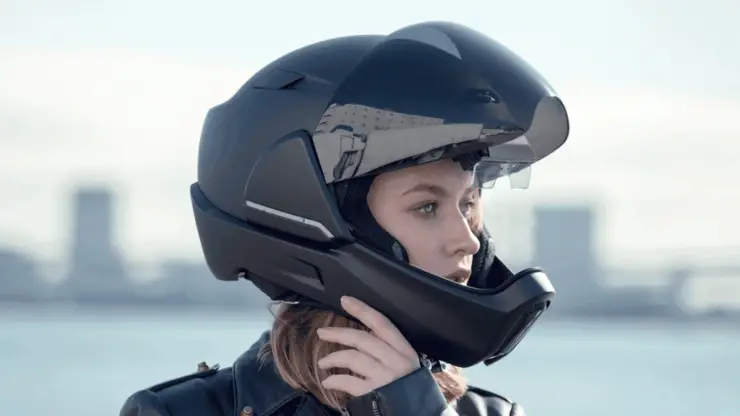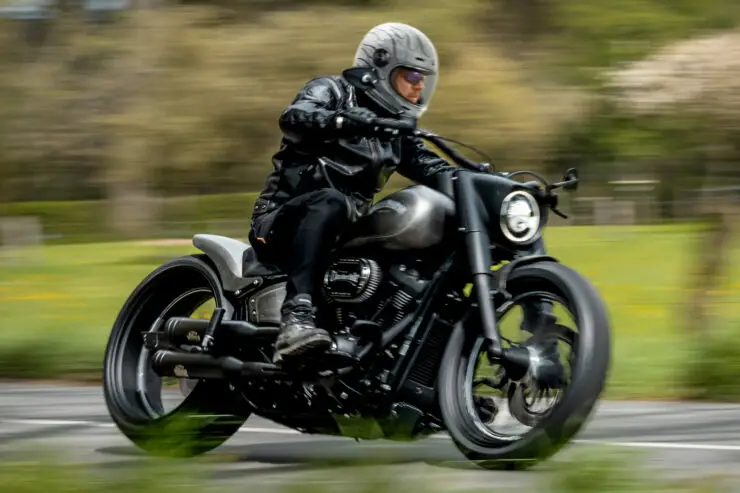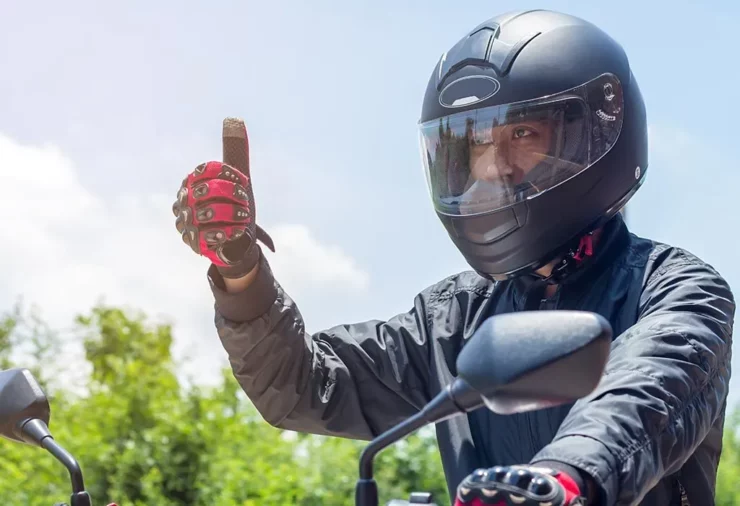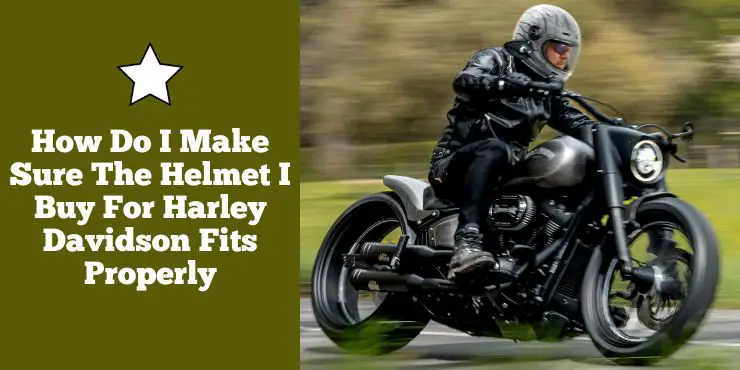When it comes to Harley-Davidson riding, safety is a top priority. A good helmet is key to your protection, but how do you make sure it fits properly?
Ensure a proper helmet fit by measuring your head circumference, trying on helmets, checking for snugness without discomfort, and ensuring it doesn’t move excessively when you shake your head.
In this article, we’ll help you find the perfect fit for your Harley-Davidson helmet so you can ride with confidence! From measuring your head to understanding helmet sizes – we’ll give you the tips and tricks you need to ensure you have the right helmet for your ride. So, let’s get started and make sure you have the perfect fit for your Harley-Davidson helmet!
Why is it important to get the right fit for a Harley-Davison Helmet?
Helmets are an important piece of safety equipment for motorcycle riders and Harley-Davidson recognizes their importance in protecting bikers on the road. A motorcycle essentially serves as a protective barrier between the rider’s head and potential impact during accidents or collisions.
>>> Click here to read our review of the Best Helmet For Harley-Davidson <<<
A helmet is a specially designed headgear that aims to safeguard the rider’s head and minimize the risk of head injuries. It consists of a hard outer shell and an inner lining that absorbs impact energy. The outer shell is typically made using materials like fiberglass, polycarbonate, or carbon fiber, which provides strength and durability. The inner lining, often composed of expanded polystyrene (EPS) foam is designed for absorbing and dispersing the impact force, reducing the risk of skull fractures or brain injuries.
It is important to get the right fit for a Harley-Davidson helmet for a wide variety of reasons such as protection, stability, comfort, noise reduction, and more.
A properly fitted helmet will ensure that the protective elements are correctly positioned to provide maximum coverage and safeguard the head from potential injuries. If a helmet is too loose or too tight, it might compromise its ability to absorb impact energy effectively.
A well-fitting helmet will stay in place securely during normal riding conditions and sudden movements. It shouldn’t shift or come off easily, even in the event of an accident. Proper retention will be important for maintaining continuous protection throughout the ride.
The right fit will ensure comfort, allowing you to focus on the road without distractions. A helmet that is too loose might cause discomfort or excessive movement, whereas a helmet that is too tight could lead to headaches or pressure points. A comfortable helmet will allow the rider to enjoy their journey and extend their riding experience.
A properly fitted helmet will help reduce wind noise and external sounds, contributing to rider comfort and preventing potential hearing damage caused by prolonged exposure to loud noises during high-speed rides.

How do I make sure the helmet I buy for Harley-Davidson fits properly?
Choosing the right size helmet will be important for optimal comfort, fit, and safety. Harley-Davidson offers an impressive range of helmets designed to provide riders with superior protection on the road. To find the perfect fit for a Harley-Davidson helmet, it will be important to accurately measure your head size. Here are the steps that will answer your question how do I make sure the helmet I buy for Harley-Davidson fits properly.
Step 1: Gather the necessary tools
For measuring your head accurately, you will require a few tools such as –
- A soft tape measure – This will allow for precise measurements without causing any discomfort
- Mirror – A mirror will help ensure that the tape measure is level around your head
- Pen and paper – These will come in handy for noting down the measurements
Step 2: Measure the circumference
The circumference of your head will be the primary measurement used for determining your helmet size. First, you need to place the tape measure around your head, slightly above your eyebrows and ears. The tape measure needs to sit parallel to the ground.
Now, you should find the measurement. Make sure that the tape measure is snug against your head but not too tight. Then, read the measurement in centimeters or inches. If you are using centimeters, note down the number for reference.
Step 3: Determine the helmet size
Once you have the head circumference measurement, you will be able to use it to determine your helmet size. Harley-Davidson provides size charts that correlate measurements to specific helmet sizes. These charts can be found on Harley’s official website or obtained from authorized. Here are the general guidelines for interpreting your measurement –
- Extra Small (XS): Head circumference of around 52-54 cm (20.5-21.25 inches)
- Small (S): Head circumference of around 55-56 cm (21.65-22.05 inches)
- Medium (M): Head circumference of around 57-58 cm (22.44-22.83 inches)
- Large (L): Head circumference of around 59-60 cm (23.23-23.62 inches)
- Extra Large (XL): Head circumference of around 61-62 cm (24.02-24.41 inches)
- Double Extra Large (XXL): Head circumference of around 63-64 cm (24.8-25.2 inches)
- Triple Extra Large (XXXL): Head circumference of around 65-66 cm (25.59-25.98 inches)
Note that the measurements are approximate and might vary slightly depending on the specific helmet model and manufacturer. It is important to refer to the size chart provided by Harley-Davidson to get the most accurate size selection.
Step 4: Try on the helmet
Once you’ve determined the helmet size based on the measurements, it’ll be important to try on the helmet before you make a final decision. Different helmet models and brands might have slight variations in fit and shape. Trying on the helmet will allow you to make sure that it sits securely on your head without causing discomfort or pressure points.
While trying on the helmet, pay attention that it has a snug fit, provides comfort, and that you’re adjusting the chin strap to ensure a secure fit.
What types of helmets for Harley-Davidson bikers will you find in the market?
When it comes to riding a Harley-Davidson bike, safety will be paramount. One of the most important pieces of safety gear for bikers will be a helmet. Helmets will not only provide protection but also allow you to showcase your personal style. With a wide variety of options available, each designed to cater to different needs and preferences, you’ll have the luxury of choosing the helmet that best suits your riding style. Here are the different types of helmets for Harley-Davidson bikers available in the market –
#1. Full-face helmets
Full-face helmets offer the most comprehensive coverage and protection. They feature a hard outer shell that covers the entire head. These helmets typically come with a built-in visor or face shield that protects the rider’s eyes from wind, debris, and the elements. You can expect these helmets to deliver superior impact protection, excellent ventilation systems, and reduced wind noise. They are the go-to choice for riders looking for maximum safety and comfort without compromising on style.
#2. Open-face helmets
Open-face helmets cover the top, sides, and back of the head but leave the face exposed. They offer a sense of freedom and a more extensive field of vision while still providing significant protection. Open-face helmets are popular among riders who prefer a classic, retro, or who desire a helmet that allows for easy communication and interaction with others. However, it is important to note that open-face helmets provide less protection to the face compared to full-face helmets.
#3. Half-helmets
Half-helmets cover only the top of the head, leaving the face, ears, and neck exposed. They offer the least amount of coverage and protection compared to the other helmet types. While half-helmets offer minimal interference to the rider’s vision and hearing, they don’t offer the same level of impact protection as full-face helmets. These helmets are quite popular among bikers who prioritize comfort, airflow, and a sense of freedom while riding.
#4. Modular helmets
Modular helmets are the helmets that combine the best features of full-face and open-face helmets offering riders the flexibility to switch between the two styles. They feature a hinged chin bar that can be lifted up, converting the helmet from a full-face to an open-face configuration. This versatility will allow you to enjoy the benefits of both styles depending on their preferences and riding conditions. Modular helmets are perfect for bikers who value convenience and adaptability.
#5. Off-road helmets
Off-road or dual sport helmets are specifically designed for bikers who venture off the paved roads, such as those who enjoy dirt biking or adventure riding. This type of helmet offers enhanced protection, featuring a distinctive shape with a large visor for improved visibility and increased airflow. These helmets typically have a peak or visor extension to shield the rider’s face from branches, dirt, and debris encountered while riding off-road. They are lightweight, durable, and well-ventilated as they cater to the demands of off-road adventures.
#6. Specialty helmets
In addition to the helmet types mentioned above, there are also specialty helmets available for specific purposes or styles. For instance, there are retro-styled helmets that evoke the classic look of the past, often inspired by vintage motorcycle designs. There are helmets designed specifically for racing, featuring aerodynamic designs, improved ventilation, and additional safety features.
When choosing a helmet for your Harley, it is important to prioritize safety, fit, and comfort. You must consider the helmet’s certification, materials, padding, ventilation, and visibility. Moreover, make sure that you select a helmet that complements your riding style and personal preferences to select a helmet that complements your riding style and personal preferences, allowing you to express your individuality while ensuring your safety on the road.

Considerations for choosing the right helmet for your Harley-Davidson
Choosing the right motorcycle helmet will be a critical decision that directly impacts your safety and comfort on the road. There are many key factors to consider when selecting a helmet. These factors will ensure you are able to make the right choice. Here are the factors you should consider for choosing the right helmet for your Harley-Davidson bike –
#1. Safety certifications
Safety needs to be your top priority when selecting a motorcycle helmet. Look for a helmet that meets internationally recognized safety standards, such as the DOT (Department of Transportation) in the United States, ECE (Economic Commission for Europe) in Europe, and Snell Memorial Foundation globally. These certifications ensure that the motorcycle helmet has undergone rigorous testing and meets minimum safety requirements.
#2. Comfort features
A comfortable helmet will enhance your riding experience and reduce fatigue on long journeys. Look for helmets that offer features like padded interior lining, adjustable chin straps, and ergonomic designs. A removable and washable liner is a valuable feature that allows you to easily maintain cleanliness and freshness.
#3. Weight and balance
A helmet’s weight and balance play a key role in comfort and long-term wearability. A lightweight helmet reduces strain on your neck muscles and minimizes fatigue. When trying on helmets, pay close attention to the weight and ensure that it feels balanced and evenly distributed on your head.
#4. Sun visor
A built-in sun visor is a convenient feature that offers protection from sunlight and glare. Look for helmets with an adjustable visor that can be operated even while wearing gloves. This feature will eliminate the need for additional sunglasses and ensures clear vision in varying lighting conditions.
#5. Ventilation
Proper ventilation is important for comfort and preventing fogging of the visor. Look for motorcycle helmets with strategically placed vents that promote airflow, allowing cool air to enter and hot air to escape. Effective ventilation will prevent excessive sweating and keeps you comfortable during rides in warm weather.
#6. Liner and cheek pads
The liner and cheek pads present inside the helmet will contribute to both comfort and safety. High-quality liners made from moisture-wicking and hypoallergenic materials keep your head dry and prevent odor buildup. Cheek pads should offer a snug fit without causing discomfort, ensuring optimal protection and stability.
#7. Style and design
While safety and comfort are paramount, the style and design of the helmet also matter to many riders. Look for a helmet that matches your personal taste and complements your riding gear. Harley-Davidson offers an impressive range of helmets with unique designs that combine style with safety.
Remember, it is important to try on different helmet models to find one that suits you best. A helmet that fits properly should be snug but not overly tight, with even pressure around your head and cheeks. It shouldn’t move or shift when you shake your head or lean forward. Investing in a high-quality helmet that meets safety certifications and provides comfort features to ensure optimal protection and enhance your riding experience. You must prioritize safety, choose a helmet that fits very well, and enjoys the freedom of the open road with confidence.
Where to buy a Harley-Davidson helmet from?
When it comes to buying a Harley-Davidson helmet, riders have multiple options to choose from. Whether you prefer the convenience of online shopping or the personalized experience of visiting a physical store, there are different places where you can purchase a Harley-Davidson helmet from. Here are the different ways through which you can buy a Harley-Davidson helmet.
#1. Harley-Davidson dealers
Harley-Davidson dealerships are largely seen as the most reliable and recommended places for buying an authentic Harley-Davidson helmet. These authorized dealers offer an extensive selection of helmets specifically designed for Harley-Davidson motorcycles.
Visiting a dealer will allow you to try on different helmet models, receive expert guidance from knowledgeable staff, and ensure that you’re purchasing a genuine product. Harley-Davidson dealerships offer a comprehensive range of helmet styles, sizes, and accessories that cater to the diverse needs and preferences of riders.
#2. Online retailers
The internet offers a convenient platform for purchasing a Harley-Davidson helmet from the comfort of your own home. Harley-Davidson’s official website is a reliable online source for purchasing its products, including helmets. Shopping online will give you access to an impressive range of helmet options, detailed product descriptions, customer reviews, and the convenience of doorstep delivery. However, whether you are purchasing from authorized online retailers or directly from the official Harley-Davidson website, you should ensure that you guarantee authenticity.
#3. Motorcycle shops
Motorcycle shops that carry a wide range of gear and accessories are another great alternative for purchasing a Harley-Davidson helmet. These shops often have a selection of helmets from various brands, including Harley-Davidson.
Visiting a motorcycle shop will allow you to explore different helmet options, try them on, and get advice from knowledgeable staff who are experienced in the world of motorcycle gear. While the selection might be more limited compared to dedicated Harley-Davidson dealerships, motorcycle shops offer a convenient alternative for immediate purchase and personalized assistance.

How to try on a helmet and make proper adjustments?
When it comes to motorcycle safety, a properly fitting helmet will be important. It will not only provide maximum protection but also ensure comfort during your rides. Trying on a helmet and making the necessary adjustments are important for achieving the perfect fit. Here are the steps for trying on a helmet and making proper adjustments –
Step 1: Put on the helmet
- Hold the helmet by the chin strap and then align it with your head
- Gently slide the helmet onto your head, ensuring the top of your head fits snugly against the interior padding
- Use both hands to guide the helmet down, making sure that it is positioned correctly
Step 2: Check for comfort
You need to make sure that the helmet is snug but not overly tight. It needs to exert uniform pressure around your head without causing any discomfort or pain. Pay close attention to pressure points. If you feel any significant pressure or pain in specific areas of your head, it might indicate that the helmet is the wrong size or shape for your head.
Step 3: Adjust the chin strap
- Fasten the chin strap securely, making sure it fits snugly under your chin
- The strap needs to be tight enough to keep the helmet in place but you should still be able to move your jaw and speak comfortably
- Avoid leaving the chin strap too loose as it could compromise the helmet’s effectiveness in the event of an impact
Step 4: Check the fit
Use your hands for checking the fit of the helmet. Gently push the helmet from the front and back for assessing the movement. The helmet should ideally remain firmly in place without shifting. You need to shake your head from side to side and up and down. The helmet must stay securely in position without any excessive movement. Tug the helmet forward and backward. It must resist movement and stay firmly in place.
Step 5: Identify any signs of the wrong size
- Excessive pressure points – If the helmet creates any painful pressure points on your forehead, temples, or the sides of your road, it might be too small
- Loose fit – If you’re able to move the helmet around your head with ease or it feels loose, it might be too large
- Excessive movement – If the helmet shifts around your head when you move or shake your head, it might be too big
- Slipping down – If the helmet slides down over your eyes, it is a clear indication that it is too big and requires adjustment or a different size
Step 6: Make necessary adjustments
Many Harley-Davidson helmets come with interchangeable cheek pads of varying thicknesses. If the helmet is too tight, you can try replacing the cheek pads with thinner ones for a more comfortable fit.
Some helmets will allow you to adjust the interior padding by adding or removing inserts. This feature will help fine-tune the fit for optimal comfort.
The retention system, typically a D-ring or quick-release buckle, can be adjusted for achieving a snug fit under your chin. Follow the manufacturer’s instructions for proper adjustment.
Remember, everyone’s head shape is different so it is important to try different helmet models and sizes to find the one that fits you best. If you are not sure about the fit, seek assistance from a knowledgeable salesperson or helmet specialist. They can easily guide you in selecting the right size and offer valuable advice based on their expertise.
FAQ
What should I consider when buying a helmet for a Harley Davidson?
When purchasing a helmet for a Harley Davidson, it’s important to consider the size, fit, and safety ratings. The size of the helmet should fit snugly around your head with no gaps. You should also make sure the helmet meets the necessary safety standards and is certified by the Department of Transportation.
How do I measure my head for a helmet?
You can measure your head for a helmet using a flexible measuring tape. Start at the center of your forehead and wrap the tape around your head, ensuring it passes over the largest part of the back of your head. The circumference of your head will determine the size of the helmet you need.
What should I do if I’m not sure if the helmet fits?
If you’re unsure if the helmet fits properly, it’s best to try it on before purchasing. You may also want to ask a professional to evaluate the fit and make sure it meets the necessary safety standards. Additionally, helmets should be replaced every five years or after any significant impact, so it’s important to keep track of when you purchased your helmet.
>>> Read more about Helmets for Harley-Davidson Riders <<<

